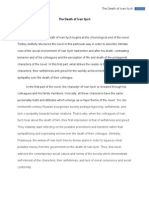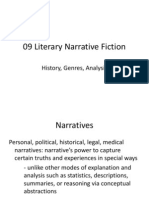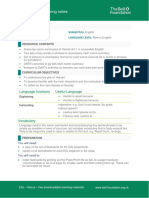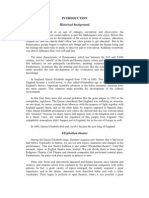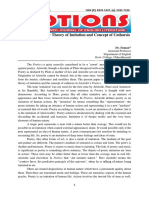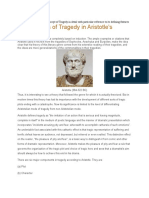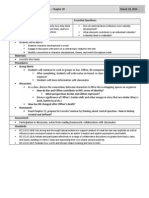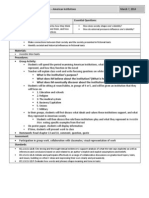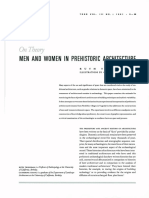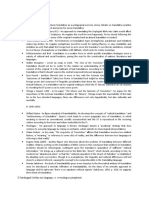Hamlet Intro
Uploaded by
api-240934338Hamlet Intro
Uploaded by
api-240934338R English 4 Hamlet Elizabethan Era and Hamlet Introduction Rachel Lenkei
November 18, 2013
Overview/Rationale:
This unit will focus on one of Shakespeares tragic plays, Hamlet. Through guided reading of the play in class, and close reading of the text, students will be able to interpret and analyze Shakespeares writing structure and use of language. The students will also engage in discussions about the how the language of the play contributes to and helps to develop the plot, themes, characterization, and symbols. This unit is designed to enable students to more deeply comprehend Hamlets character and his transformation throughout the play, making connections to the course the mes of image and identity construction in text. In this lesson, students will be introduced to Hamlet, and will read descriptions of English history at the time that Shakespeare lived and wrote to gain an understanding of the contexts that influenced his plays.
Enduring Understandings:
How are images and identities of characters created in a text, and what are their similarities and differences?
Essential Questions:
How and Why has Shakespeare remained relevant and popular today?
Objectives:
Students will be able to: o Explain the changes in English society during the Renaissance and Elizabethan Era o Describe aspects of English history that are relevant to Shakespeares writing of Hamlet o Identify evidence of foreshadowing in Act 1.1
Materials: Student copies of Hamlet, English History PowerPoint Procedures: Warm-up: o Pass out copies of Hamlet Instruction: o PowerPoint presentation on Elizabethan Era and introduction to Shakespeare and Hamlet Before Shakespeare slides, ask students: What do you know about Shakespeare? Write student responses on white board (4 min) o Review Shakespeare using PowerPoint, addressing student comments (10 min) Shakespeare wrote for an audience, wanted his writing to appeal to both English nobles and commoners Wrote about love, beauty, death, marriage etc., common themes that people can relate to Uses language and specific words and rhythms to emphasize the meanings of what a character or poem is saying o How is Shakespeare still used in everyday life? List on white board Phrases we owe . . . (http://www.businessinsider.com/everyday-phrases-from-shakespeare-2013-9) Is Shakespeare important today? Why is he still relevant? Is he still relevant? He has made many very long lasting contributions to the English language o Transition to review of iambic pentameter (7 min) Play clips from TED Talk about iambic pentameter (http://tedxtalks.ted.com/video/TEDxAldeburgh-Akala-Hip-Hop-Sha ) During intro quiz, pause after each question to have students answer, stop at 3:30 Start at 7:25 (iambic pentameter) to 9:25; maybe 15:00? In class guided reading: (22 min) o Select students to read parts for Act 1.1 o Stop after Horatio, In what particular thought to work I know not . . . to check for comprehension, review events (6 min) What is the setting (time and place)?
R English 4 Hamlet Elizabethan Era and Hamlet Introduction Rachel Lenkei
November 18, 2013
Who are the characters? What are they afraid of? o If time: Continue reading, stop when Ghost enters (pg.5), ask students to interpret Horatios lines and his analysis of the Ghosts appearance (3 min for reading) Closure: (5 min) o Tell students to finish Act I for homework and answer guiding questions Identify images of foreshadowing in the text Why doesnt the Ghost talk to the men? Why does he leave at the end of the scene? Homework: Finish reading Act I, take/review notes, identify key lines; answer guiding questions Assessment:
Participation in guided reading; responses to teachers questions
CC.1.3.11-12.A: Determine and analyze the relationship between two or more themes or central ideas of a text, including the development and interaction of the themes; provide an objective summary of the text. 1.1.12.A: Apply appropriate strategies to construct meaning through interpretation and to analyze and evaluate authors use of techniques and elements of fiction and non-fiction for rhetorical and aesthetic purposes. 1.1.12.C: Analyze textual context to determine or clarify the meaning of unfamiliar or ambiguous words and to draw conclusions about nuances or connotations of words 1.1.12.D: Demonstrate comprehension / understanding before reading, during reading, and after reading on a variety of grade level texts to support understanding of a variety of literary works from different cultures and literary movements.
Standards:
Reflections:
You might also like
- The Lake at The End of The World Study GuideNo ratings yetThe Lake at The End of The World Study Guide6 pages
- KS3 Scheme of Learning - Dystopia: English 8 Dystopia (Reading Focus)No ratings yetKS3 Scheme of Learning - Dystopia: English 8 Dystopia (Reading Focus)6 pages
- 09 Literary Narrative Fiction: History, Genres, AnalysisNo ratings yet09 Literary Narrative Fiction: History, Genres, Analysis60 pages
- Shakespeare and Race - Relationship With DesdemonaNo ratings yetShakespeare and Race - Relationship With Desdemona5 pages
- Aristotle Poetics: Dealing With Lofty Matters Dealing With Base MattersNo ratings yetAristotle Poetics: Dealing With Lofty Matters Dealing With Base Matters4 pages
- Essay: Waiting For Godot by Samuel BeckettNo ratings yetEssay: Waiting For Godot by Samuel Beckett6 pages
- Chapter One:: Introduction and Theoretical BackgroundNo ratings yetChapter One:: Introduction and Theoretical Background24 pages
- "To Be Acutely Conscious Is A Disease, A Real, Honest-To-Goodness Disease." Dostoevsky, Notes From TheNo ratings yet"To Be Acutely Conscious Is A Disease, A Real, Honest-To-Goodness Disease." Dostoevsky, Notes From The5 pages
- Summary Season of Migration To The North Chapters SummaryNo ratings yetSummary Season of Migration To The North Chapters Summary7 pages
- Gothic Literature: Subgenre of Romanticism 1800-1860100% (2)Gothic Literature: Subgenre of Romanticism 1800-186033 pages
- Revolt-Of-Satan-In-Paradise-Lost-Book-1-71585 - Rudrani DattaNo ratings yetRevolt-Of-Satan-In-Paradise-Lost-Book-1-71585 - Rudrani Datta7 pages
- Sokel On Kafkas Metamorphosis - From Marx To MythNo ratings yetSokel On Kafkas Metamorphosis - From Marx To Myth8 pages
- IB Langlit Paper 1 Comic Strip Glossary of TermsNo ratings yetIB Langlit Paper 1 Comic Strip Glossary of Terms7 pages
- Frankenstein - Rime of The Ancient Mariner NotesNo ratings yetFrankenstein - Rime of The Ancient Mariner Notes2 pages
- M-02.Aristotle's Poetic Concept - An Analysis of Poetry (ENG) PDFNo ratings yetM-02.Aristotle's Poetic Concept - An Analysis of Poetry (ENG) PDF15 pages
- Interactive Approaches To Second or Foreign Language Reading and Their Implications100% (1)Interactive Approaches To Second or Foreign Language Reading and Their Implications5 pages
- Men and Women in Prehistoric Architecture PDFNo ratings yetMen and Women in Prehistoric Architecture PDF20 pages
- Cross Curricular Collaboration Utilizing Maus by Art SpiegelmanNo ratings yetCross Curricular Collaboration Utilizing Maus by Art Spiegelman11 pages
- Science Technology and Society - Critique Paper For Technocratic ParadigmNo ratings yetScience Technology and Society - Critique Paper For Technocratic Paradigm2 pages
- Dates & Deadlines 2019-2020: Events FALL 2019 WINTER 2020 SPRING 2020No ratings yetDates & Deadlines 2019-2020: Events FALL 2019 WINTER 2020 SPRING 20201 page
- Death in Rammiside Period Essay StructureNo ratings yetDeath in Rammiside Period Essay Structure9 pages
- Getting Through (Intercultural Exchanges)No ratings yetGetting Through (Intercultural Exchanges)3 pages
- Organization Process Structure and Culture 1No ratings yetOrganization Process Structure and Culture 115 pages
- Poverty Is The Outcome of A Habitual Entering Into Commitments That One Is Inherently Incapable of HonouringNo ratings yetPoverty Is The Outcome of A Habitual Entering Into Commitments That One Is Inherently Incapable of Honouring3 pages





